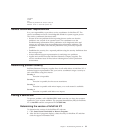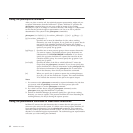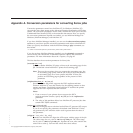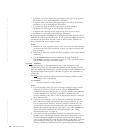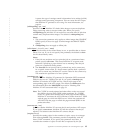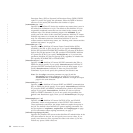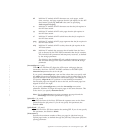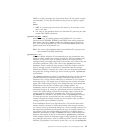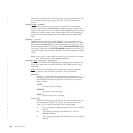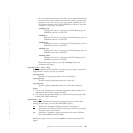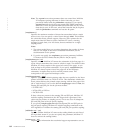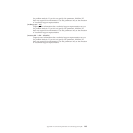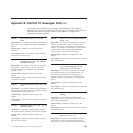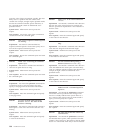
DJDEs. Use this parameter only if the inline forms do not specify a paper
size internally, or if the JDL and JDEs for the job do not specify a paper
size.
Notes:
1. A4LT is a custom paper size that is 8.5 inches by 11.69 inches, or 216
mm by 297 mm.
2. The value of this attribute affects how InfoPrint XT processes jobs that
contain FILE DJDE commands.
[xpattern_set=300-1
| 300-2]
Specifies the type of shading patterns that InfoPrint XT uses when it
processes Xerox FORMS$, FORMSX, and ISISPX fonts during metacode
data-stream conversion. 300-1 specifies the shading patterns that Xerox
97xx, 4x50, and 4x90 printers use. This is the default. 300-2 specifies the
patterns that Xerox 4x35 printers use.
Note:
The value of this attribute affects how InfoPrint XT processes jobs
that contain FILE DJDE commands.
[xpcctest=yes
| no]
Specifies whether InfoPrint XT automatically tests the onlineXerox data
stream to verify whether the carriage controls are ANSI or machine code.
InfoPrint XT passes the type of carriage control to its online (jes3211)
carriage-control processing component. It first looks at the value of the xcc
conversion parameter. Then, if the value of the xpcctest conversion
parameter is yes, it reads the first records of the job to further verify the
type of carriage controls. If InfoPrint XT determines that the carriage
controls are different, it ignores the value of the xcc conversion parameter
and passes the carriage control type that it found to jes3211. xpcctest=yes
is the default.
The xpcctest parameter is useful for installations that have Xerox jobs that
contain both ANSI and machine carriage controls but that do not use
Download for z/OS to transfer online jobs to InfoPrint XT. For example, a
multi-step job on z/OS might have an initial step that consists of banner
pages with ANSI carriage controls. The subsequent steps that contain the
actual data for the job have machine code carriage controls. For
installations that use Download for z/OS, InfoPrint XT provides the -p
download directive. By using the -p download directive, InfoPrint XT can
convert the ANSI carriage controls for the banner pages so that all the
carriage controls in the job are machine code. Then, you can specify
xcc=machine. As directed by the default value of xpcctest=yes, InfoPrint
XT reads the first few records that have the converted ANSI carriage
controls. Because all carriage controls are now machine code, it passes a
carriage control type of machine to jes3211.
If the installation does not use Download for z/OS and the Xerox data
streams contain a mixture of ANSI and machine code carriage controls,
you cannot use the -p download directive to convert carriage controls. The
xcc conversion parameter should specify the type of carriage controls for
the job data. Using the job described in the previous example, the xcc
parameter should have a value of machine. However, when InfoPrint XT
reads the first records of the job as directed by xpcctest=yes, it finds the
ANSI carriage controls in the banner pages. It then ignores the value of the
xcc parameter and passes a value of ANSI to jes3211. The AFP output that
InfoPrint XT generates is not correct. In this case, you can use xpcctest=no.
Appendix A. Conversion parameters for converting Xerox jobs 99
|
|
|
|
|
|
|
|
|
|
|
|
|
|
|
|
|
|
|
|
|
|
|
|
|
|
|
|
|
|
|
|
|
|
|



